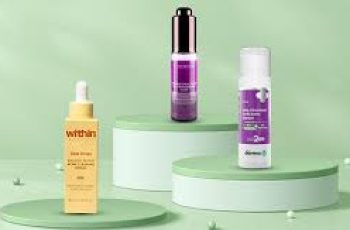
Should You Add Blue Light Skincare to Your Anti-Aging Routine?
In today’s digital age, we’re all familiar with the constant presence of screens in our lives—whether it’s scrolling on a smartphone, working on a laptop, or binge-watching your favorite TV show. While these screens have transformed how we live, they might also be affecting our skin in ways we never considered. Specifically, blue light—the short-wavelength light emitted by electronic devices—could be contributing to premature aging, hyperpigmentation, and other skin concerns.
If you’re wondering whether blue light skincare products are just another beauty trend or if they actually offer real benefits, read on. We’ll break down what blue light is, why it can harm your skin, and how you can protect yourself using the latest skincare innovations.
What is Blue Light, and Why Is It Harmful to Your Skin?
Blue light, or high-energy visible (HEV) light, is part of the visible light spectrum that has a wavelength of 400-495 nm. You’re most familiar with it from digital devices such as smartphones, laptops, and TVs, but it’s also naturally present in sunlight.
Though blue light is not inherently bad, the increased amount of exposure we get from digital screens has raised concerns in the skincare world. According to Dr. J. Rodney, MD, a board-certified dermatologist, “Blue light is literally everywhere.” This constant exposure has prompted research into its long-term effects on skin health, and the findings aren’t entirely positive.
While blue light is primarily known for its effects on vision and sleep cycles—disrupting circadian rhythms and potentially causing eye strain—there’s a growing body of evidence suggesting it also causes oxidative stress on the skin. Oxidative stress occurs when free radicals (reactive molecules) damage cells and tissues, leading to premature aging.
Dr. Rodney explains, “Blue light can penetrate deeper into the skin than UV light, stimulating pigment-producing cells. This can lead to hyperpigmentation, wrinkles, and other signs of aging.”
One of the main concerns with prolonged blue light exposure is its potential to accelerate skin aging. Studies have shown that prolonged exposure to blue light, even from just an hour of screen time, can cause significant damage to skin cells, resulting in DNA damage, cell death, and inflammation.
In addition to these harmful effects, blue light has also been linked to conditions like melasma—a form of hyperpigmentation that causes dark patches or spots on the skin, especially on the face.
What Exactly Is Blue Light Skincare?
With the increasing awareness of blue light’s potential effects on the skin, the beauty industry has responded with a range of products specifically formulated to protect against it. Blue light skincare encompasses various products, from serums and creams to sunscreens, that claim to block or neutralize blue light’s harmful effects.
Types of Blue Light Skincare Products
Blue Light Sunscreens: These sunscreens are designed not only to protect against harmful UVA and UVB rays but also to shield against blue light. Unlike standard sunscreens, which primarily block UV radiation, blue light sunscreens contain ingredients specifically aimed at defending the skin from HEV light.
Blue Light Defense Serums: These serums often contain antioxidants and other protective ingredients that neutralize the oxidative stress caused by blue light exposure, helping to prevent premature aging and hyperpigmentation.
Night Creams: Some night creams are formulated with ingredients like peptides and retinoids that help repair the skin overnight, reversing damage caused by environmental factors like blue light.
Digital Defense Creams: These are lightweight, day-time creams that protect against a variety of environmental stressors, including blue light, pollution, and infrared radiation. They often contain soothing, hydrating ingredients along with antioxidants to combat oxidative stress.
Do Blue Light Skincare Products Actually Work?
Now, the big question: Do these blue light skincare products live up to the hype?
While the research on blue light’s long-term impact on the skin is still in its early stages, the evidence suggests it’s a good idea to incorporate blue light protection into your routine. Here’s why:
1. Research Supports the Need for Protection
The scientific community is increasingly acknowledging the role of blue light in skin aging. A study found that prolonged exposure to blue light from screens leads to reactive oxygen species (ROS) generation—molecules that cause oxidative stress and lead to cell damage. This process is a key factor in the aging of skin.
Blue light exposure has also been linked to pigmentation issues, especially for those who are already prone to melasma. Studies have shown that blue light stimulates pigment-producing cells called melanocytes, resulting in darker pigmentation, especially on the face.
2. Blue Light Sunscreens Provide Added Protection
Standard sunscreens, while essential for blocking UV rays, don’t offer adequate protection from blue light. That’s where blue light sunscreen comes in. These specialized sunscreens contain ingredients like iron oxide pigments, which are effective at blocking visible light and can provide additional protection against the skin-aging effects of blue light.
Dr. Gary Goldenberg, MD, a dermatologist based in New York, recommends tinted sunscreens for blue light protection, stating, “Tinted sunscreen with SPF 30 and higher can protect the skin from blue light as well as UVA and UVB.” The key here is the iron oxide pigments, which have been shown to absorb blue light, preventing it from penetrating the skin and causing damage.
3. Antioxidants in Blue Light Skincare
Many blue light skincare products contain antioxidants, which play a key role in neutralizing free radicals generated by blue light exposure. These antioxidants help prevent oxidative stress, which is a major contributor to premature aging. Look for products with ingredients like vitamin C, vitamin E, and ferulic acid, which are all well-known for their ability to fight free radical damage and promote skin rejuvenation.
Should You Add Blue Light Skincare to Your Routine?
While we still need more research to fully understand the long-term impact of blue light on the skin, dermatologists agree that it’s better to be proactive in protecting your skin from potential damage. If you spend a significant amount of time in front of screens, incorporating blue light skincare into your routine can help minimize the long-term effects of exposure.
How to Incorporate Blue Light Skincare into Your Routine:
Start with a Blue Light-Blocking Sunscreen: Choose a tinted sunscreen with SPF 30 or higher, which will protect your skin from both UV rays and blue light.
Use Antioxidant-Rich Serums: A serum packed with antioxidants like vitamin C can help neutralize free radicals and protect the skin from oxidative stress.
Incorporate Night Creams: At night, use a reparative cream to help restore your skin while you sleep. Look for products with retinol or peptides to encourage cell turnover and repair damage caused by environmental exposure.
Follow a Consistent Skincare Routine: Just like with UV protection, consistency is key. Make sure you’re cleansing regularly, moisturizing, and protecting your skin with the appropriate skincare products.
Final Thoughts
Blue light skincare products are becoming an increasingly popular part of many anti-aging routines—and for good reason. With growing evidence of blue light’s harmful effects on the skin, it’s smart to add products that protect against it. While we’re not about to abandon our devices anytime soon, adding a blue light defense product to your regimen can help minimize the impact on your skin and keep you looking youthful for years to come.
So, if you’re concerned about digital aging and skin pigmentation, adding a blue light protection step could be an investment worth making for your skincare routine.


